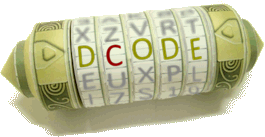Tool to display / translate a Forsyth-Edwards notation (FEN) of a chess game. The line notation FEN allows to describe any position of a chess game.
Forsyth-Edwards Notation - dCode
Tag(s) : Notation System, Board Games
dCode is free and its tools are a valuable help in games, maths, geocaching, puzzles and problems to solve every day!
A suggestion ? a feedback ? a bug ? an idea ? Write to dCode!
Forsyth-Edwards Notation
FEN Reader
Answers to Questions (FAQ)
What is FEN notation? (Definition)
Forsyth-Edwards notation (FEN) is a standardized representation of chess positions as a string. It describes the arrangement of the pieces on the board at a given time (a snapshot) as well as information relating to the game, whose turn it is, castlings etc.
How does FEN notation work?
The FEN notation is made up of six fields separated by spaces. These fields represent, in order: the arrangement of the pieces, the move, the castling possibilities, the possibility of taking en passant, the number of half-moves elapsed, and the move number.
FEN starts by encoding the content of the chessboard by rows from top to bottom (seen from the white side). The characters describing the parts are:
| K | White King | k | Black King |
| Q | White Queen | q | Black Queen |
| R | White Rook | r | Black Rook |
| B | White Bishop | b | Black Bishop |
| N | White Knight | n | Black Knight |
| P | White Pawn | p | Black Pawn |
| 1-8 | 1 to 8 empty boxes |
Example: The starting position of a chess board is: rnbqkbnr/pppppppp/8/8/8/8/PPPPPPPP/RNBQKBNR
The chessboard description is completed with 5 informations:
| w or b | Indicates the next player (w = white, b = black) |
| KQkq | Indicates possible castling. K and / or Q for black castle respectively coded King or Queen and likewise k and / or q for the white castle, "-" if none |
| - or coordinate | Coordinates of a possible case of taking en passant |
| 0 to 50 | Number of moves since last catch |
| 1 to 999 | Move number |
Pawn promotion is represented by the piece to which the pawn is promoted.
FEN notation does not take into account position repetitions.
What does FEN stand for?
FEN is the acronym for Forsyth-Edwards Notation, named after David Forsyth, a Scottish journalist who invented this notation and Steven Edwards who adapted it to make it unambiguous and compatible with computers.
See also SAN notation
Source code
dCode retains ownership of the "Forsyth-Edwards Notation" source code. Any algorithm for the "Forsyth-Edwards Notation" algorithm, applet or snippet or script (converter, solver, encryption / decryption, encoding / decoding, ciphering / deciphering, breaker, translator), or any "Forsyth-Edwards Notation" functions (calculate, convert, solve, decrypt / encrypt, decipher / cipher, decode / encode, translate) written in any informatic language (Python, Java, PHP, C#, Javascript, Matlab, etc.) or any database download or API access for "Forsyth-Edwards Notation" or any other element are not public (except explicit open source licence). Same with the download for offline use on PC, mobile, tablet, iPhone or Android app.
Reminder: dCode is an educational and teaching resource, accessible online for free and for everyone.
Cite dCode
The content of the page "Forsyth-Edwards Notation" and its results may be freely copied and reused, including for commercial purposes, provided that dCode.fr is cited as the source (Creative Commons CC-BY free distribution license).
Exporting the results is free and can be done simply by clicking on the export icons ⤓ (.csv or .txt format) or ⧉ (copy and paste).
To cite dCode.fr on another website, use the link:
In a scientific article or book, the recommended bibliographic citation is: Forsyth-Edwards Notation on dCode.fr [online website], retrieved on 2025-12-21,
